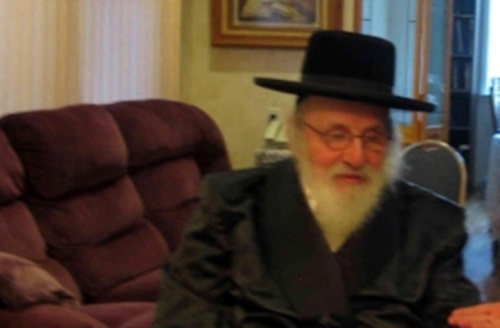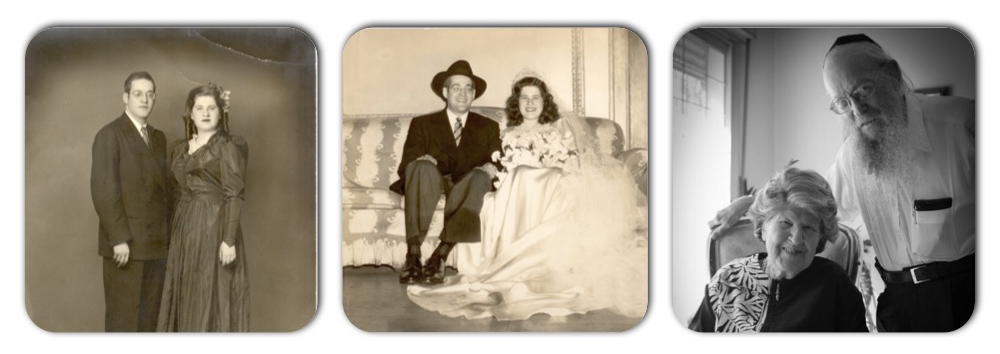The Sulitzer Rebbe – Rabbi Rubin from Far Rockaway passed away this Tuesday night. The following is an article from www.vosizneias.com about him. In the article it mentions a story about a Lubavitcher that came one Friday night to daven and a story with a Nusach Ari siddur. What isn’t mentioned is that that Lubavitcher was Daddy HK”M. The story was that Daddy had gone to Omi & Opi for Shabbos and went to shul Friday night with Levi A”H and asked the Rabbi if he had any Lubavitcher siddurim which the Rabbi said he has one and went to get it. He gave the siddur To Daddy but since Levi was a young kid Daddy gave it to Levi A”H to daven in and Levi dropped it and that’s how they found the money that helped them save the shul.

Far Rockaway, NY – The entire community is mourning the passing this past Tuesday night of one of the founders and pioneers of the Torah community in Far Rockaway. Rav Shmuel Shmelka Rubin, the Sulitzer Rebbe, represented to all who knew him, the authentic bearer of the Chassidishe Yiddishkeit of Europe.
Rav Rubin zt”l was born in 1925, and was a scion of the Ropshitzer dynasty of Chassidus, descendants of Rav Naftoli Tzvi Horowitz of Ropshitz. Rav Naftoli Tzvi was a contemporary of the author of the famed Nesivos HaMishpat on Choshen Mishpat, and studied with him. Rav Naftoli Tzvi was the author of the Zera Kodesh, a work that inspired those who learned it to reach remarkable heights in Dveikus Bashem.
“What defined him?” He came to Far Rockaway when only the White Shul was here,” remarked Rabbi Amnon Nissan, a congregant. “He remained true to his Chassidish mesorah – unwavering.”
Rav Rubin came from an illustrious family. His father, Rav Yaakov Yisroel Yeshurun Rubin, was the Av Beis Din of Sulitza and Sasragen in Romania. He was the son-in-law of Rav Yissachar Ber Rosenbaum, the Rebbe of Stroznitz. Both of his parents were murdered in the Nazi holocaust. A twenty year old Rav Rubin saw what he must do – to help rebuild Torah and the communities that no longer existed.
Rav Rubin had a special relationship with the Satmar Rebbe, Rav Yoel Teitelbaum, zt”l. After the war the Satmar Rebbe saw his own unique task to build up the Kehillos that were devastated by the Nazis yimach shmam. He saw a kindred spirit in the Sulitzer. At the Rebbe’s prompting, Rav Rubin and his Akeres HaBayis moved to Far Rockaway. The Sulitzer represented the dynamicism and vibrancy of Ropshitzer Chassidus. He arrived in Far Rockaway only a few years after the war.
They gave up all the conveniences in Brooklyn and came to a place where there were Chassidim. The Rubin family had a number of children, who had few peers to play with. Rav Rubin was undeterred. He came here to establish a religious community. And establish he did.
Many times, in the beginning, they had no minyan. The Rubin home was the only house in town when a meshulach would come, he could eat and sleep without a problem. He and the rebbitzen were the paragons of hachnasas orchim. And Meshulachim flocked to stay in his home, even sleeping on the floor when there were no beds.
“He always had a kind word and very insightful advice whenever we went to him,” remarked Mrs. Bruchie Goldfedder. “I was also quite surprised at his mastery of English.”
Yet although he could communicate in perfect English, in the shul and at home, the family spoke Yiddish all the time. All the drashos he delivered were in Yiddish because they wished to hold on tightly to their Mesorah – their holy inheritance of Ropshitz. It was so very important to them.
Once, one of his mispalleim gave the Rebbe a ride to the Catskills in New York. Rav Rubin related to him that after they were released from the camps and entered the Displaced person camps – the need for religious Seforim was most acute. He and another bochur found in a taharah house of a Jewish cemetery just two books: One was the Meor Einayim of the Chernobler Rebbe, and the other was the siddur of the Baal HaTanya. Rav Rubin had found the Meor Einayim. The bachur, however, was a descendant of the Chernobyl Chassidish dynasty. He asked Rav Rubin to exchange the seforim. How could Rav Rubin refuse?
Years later, in Far Rockaway, as the shul was being built, Rav Rubin was in dire need of funds. A contractor, was pressuring for payment with threats. That Friday night, a Lubavitch Mispallel in the shul wished to use the siddur with his own Nusach. Rav Rubin went to the attic to retrieve the old siddur he had saved after the war. The Siddur fell down. In the binding there were thirteen one hundred American dollar bills.
The Rebbe, in his remarkable honesty, did not take the money. He searched high and low for the original owner of the Siddur. Only when he was satisfied that it was truly hefker did he take the money and use it. He felt it was a Matana from HaKadosh Boruch Hu.
At one point when the Beis Midrash became small, it was in their living room, there was a large piece of land available on Beach 9th on Roosevelt Court. The land was adjacent to their house and was going on public auction. Mr. Fox, a lawyer, loved the Rebbe with heart and soul. He stood up at the platform of the auction and declared, “Please, Do not bid against the Rebbe.” Those around listened. How could they not?
The entire lot was sold for $15,000. The lot presently occupies the new building of the Rebbe’ shul, which gradually was improved until the beautiful structure we see today. This too, of course, was one of Hashem’s nissim. The Rebbe would always take revii so that no one would ever get offended. He would always right a Jewish date. He was trying to hold onto his Mesorah.
The Rebbe personified the Middah of humility. Once an incident occurred in Shul where someone had received revii, the fourth Aliyah on a Shabbos morning. He felt that this Aliyah was not in accordance with his honor and became angry. The Rebbe from that point on would take Revii himself, so that no one would ever feel slighted that it was not an important Aliyah.
His love of people transcended barriers. Once, a child in a local Yeshiva was facing difficulty. He was acting out as teen-agers are wont to do. The mother was at wit’s end as to what to do. Rav Rubin offered to learn with the young man himself. To everyone’s shock, he did. What was even more surprising was that the young man turned around developed into a beautiful Ben Torah.
The Rebbe would never compromise regardless of the pressure he faced. Rav Rubin personified the notion of “Ki Haim Chayeinu”, yet he was not a supporter of learning Shas in English. When the Artscroll Schottenstein Talmud first came out, he did not initially wish it in the shul. No one, however, was terribly upset with him in this regard because they knew that it came from his strong regard for the Mesorah. Eventually he had to capitulate and people did bring it to the Gemorah Shiurim.
He was an extraordinary baal chessed, many times he was short on funds. In order for him to survive, he would often have to borrow money. At no time, however, was he ever late in repaying. He would even pay his obligations a day before it was due.
A number of years ago, this author was zocheh to house an emergency guest, a Rosh Kollel from Meah Shearim who was stranded at Kennedy airport without his luggage. His Shtreimel and Kapota were on the way to England on a Thursday midnight flight and he was not allowed to board the plane. When this author went to the Rubin house to borrow a Shtreimel, the Rubins offered the Rosh Kollel a choice of three. Such was the Rubin family Hachnasas Orchim and Chessed.
He was humble and always tried to play a role in not showing off, his vast knowledge of Torah and Chassidus.
The neighborhood of Far Rockaway soon deteriorated to the point where people started to move to Lawrence and beyond. This greatly grieved the Rebbe personally and affected the attendance of the shul as well. The Rebbe thought hard and invented the term “West Lawrence.” This was his brainchild.
Eventually, people did stop moving, but he went a step further. He assured them that things will change and the market would rise again. The Rebbe’s words were prescient. Far Rockaway became one of most expensive neighborhoods in New York. Much of this was on account of his wisdom. In spite of the neighborhood’s initial decline, those that did move away walked to shul on Shabbos. Sometimes it would even be a half hour or an hour walk. They did this to attend the Kehilas Yaakov shul of Rav Shmuel Rubin zt”l
Approximately 25 years ago, the Rebbe established a Tehillim Kollel in Yerushalayim. The Rebbe travelled to Eretz Yisroel and many people came to seek his advice there in many situations. He was loved by all.
The loss of the Sulitzer Rebbe certainly leaves a vast void. Not only in Far Rockaway, but throughout New York and the world. But the one consolation is that his dear son, Reb Yankel, a prodigious Talmid Chachom in his own right , is following in his remarkable father’s footsteps – in all of his mesorahs. As a baal Hachnasas orchim Rav Yankel hosts the most important guests, as well as the near homeless. His friendly smile and behavior to all will assure that he will be successful just as his father zt”l was.
Original article can be found here http://www.vosizneias.com/133782/2013/06/19/far-rockaway-ny-the-end-of-an-era-the-sulitzer-rebbe/
